Dell PP17L User Manual
Dell™ Latitude™ D510
Quick Reference Guide
Model PP17L
w w w . d e l l . c o m | s u p p o r t . d e l l . c o m

Notes, Notices, and Cautions
NOTE: A NOTE indicates important information that helps you make better use of your computer.
NOTICE: A NOTICE indicates either potential damage to hardware or loss of data and tells you how to avoid the problem.
 CAUTION: A CAUTION indicates a potential for property damage, personal injury, or death.
CAUTION: A CAUTION indicates a potential for property damage, personal injury, or death.
Abbreviations and Acronyms
For a complete list of abbreviations and acronyms, see the User’s Guide (depending on your operating system, double-click the User’s Guide icon on your desktop or click the Start button, click Help and Support Center, and click User and system guides).
If you purchased a Dell™ n Series computer, any references in this document to Microsoft® Windows® operating systems are not applicable.
NOTE: Some features may not be available for your computer or in certain countries.
Information in this document is subject to change without notice. © 2005 Dell Inc. All rights reserved.
Reproduction in any manner whatsoever without the written permission of Dell Inc. is strictly forbidden.
Trademarks used in this text: Dell, the DELL logo, and Latitude are trademarks of Dell Inc.; Intel, Pentium, and Celeron are registered trademarks of Intel Corporation; Microsoft and Windows are registered trademarks of Microsoft Corporation.
Other trademarks and trade names may be used in this document to refer to either the entities claiming the marks and names or their products. Dell Inc. disclaims any proprietary interest in trademarks and trade names other than its own.
Model PP17L
February 2005 |
P/N J8413 |
Rev. A00 |

Contents
Finding Information . . . . . . . . . . . . . . . . . . . . . . . . . . . . . . . . |
5 |
Setting Up Your Computer . . . . . . . . . . . . . . . . . . . . . . . . . . . . . |
9 |
Battery Performance . . . . . . . . . . . . . . . . . . . . . . . . . . . . . . . |
10 |
Checking the Battery Charge . . . . . . . . . . . . . . . . . . . . . . . . . . |
12 |
Dell™ QuickSet Battery Meter . . . . . . . . . . . . . . . . . . . . . . . |
12 |
Microsoft® Windows® Power Meter . . . . . . . . . . . . . . . . . . . |
12 |
Charge Gauge. . . . . . . . . . . . . . . . . . . . . . . . . . . . . . . . |
13 |
Health Gauge . . . . . . . . . . . . . . . . . . . . . . . . . . . . . . . . |
13 |
Low-Battery Warning . . . . . . . . . . . . . . . . . . . . . . . . . . . . |
14 |
Charging the Battery . . . . . . . . . . . . . . . . . . . . . . . . . . . . . . . |
14 |
Removing a Battery . . . . . . . . . . . . . . . . . . . . . . . . . . . . . . . |
15 |
Installing a Battery. . . . . . . . . . . . . . . . . . . . . . . . . . . . . . . . |
15 |
Storing a Battery . . . . . . . . . . . . . . . . . . . . . . . . . . . . . . . . . |
15 |
About Your Computer. . . . . . . . . . . . . . . . . . . . . . . . . . . . . . . |
16 |
Front View. . . . . . . . . . . . . . . . . . . . . . . . . . . . . . . . . . |
16 |
Left View . . . . . . . . . . . . . . . . . . . . . . . . . . . . . . . . . . |
17 |
Right View. . . . . . . . . . . . . . . . . . . . . . . . . . . . . . . . . . |
17 |
Back View. . . . . . . . . . . . . . . . . . . . . . . . . . . . . . . . . . |
18 |
Bottom View . . . . . . . . . . . . . . . . . . . . . . . . . . . . . . . . |
18 |
Solving Problems . . . . . . . . . . . . . . . . . . . . . . . . . . . . . . . . |
19 |
Notebook System Software. . . . . . . . . . . . . . . . . . . . . . . . . |
19 |
Lockups and Software Problems . . . . . . . . . . . . . . . . . . . . . . |
19 |
Running the Dell Diagnostics . . . . . . . . . . . . . . . . . . . . . . . . |
21 |
Index . . . . . . . . . . . . . . . . . . . . . . . . . . . . . . . . . . . . . . . . . |
25 |
Contents 3

4 Contents
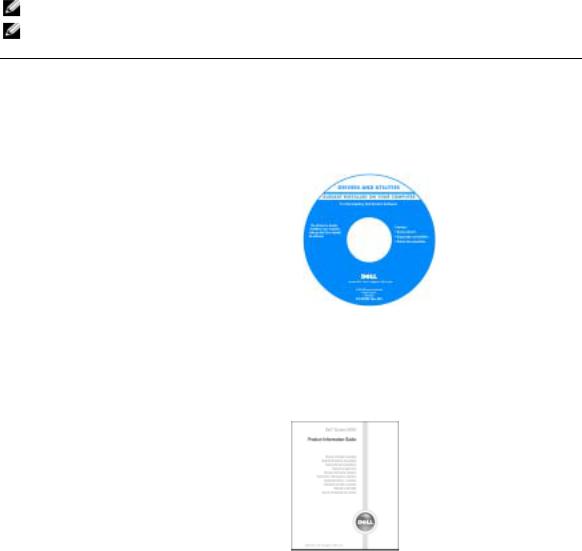
Finding Information
NOTE: Some features may not be available for your computer or in certain countries.
NOTE: Additional information may ship with your computer.
What Are You Looking For? |
Find It Here |
|
|
• A diagnostic program for my computer |
Drivers and Utilities CD (also known as ResourceCD) |
• Drivers for my computer |
Documentation and drivers are already installed on your |
• My computer documentation |
computer. You can use the CD to reinstall drivers, run the |
• My device documentation |
Dell Diagnostics, or access your documentation. For more |
• Notebook System Software (NSS) |
information, see your User’s Guide. |
|
|
|
Readme files may be |
|
included on your CD to |
|
provide last-minute |
|
updates about technical |
|
changes to your |
|
computer or advanced |
|
technical-reference |
|
material for technicians |
|
or experienced users. |
|
NOTE: Drivers and documentation updates can be found at |
|
support.dell.com. |
|
NOTE: The Drivers and Utilities CD is optional and may not |
|
ship with your computer. |
|
|
• Warranty information |
Dell™ Product Information Guide |
• Terms and Conditions (U.S. only) |
|
• Safety instructions |
|
• Regulatory information |
|
• Ergonomics information |
|
• End User License Agreement |
|
Quick Reference Guide |
5 |
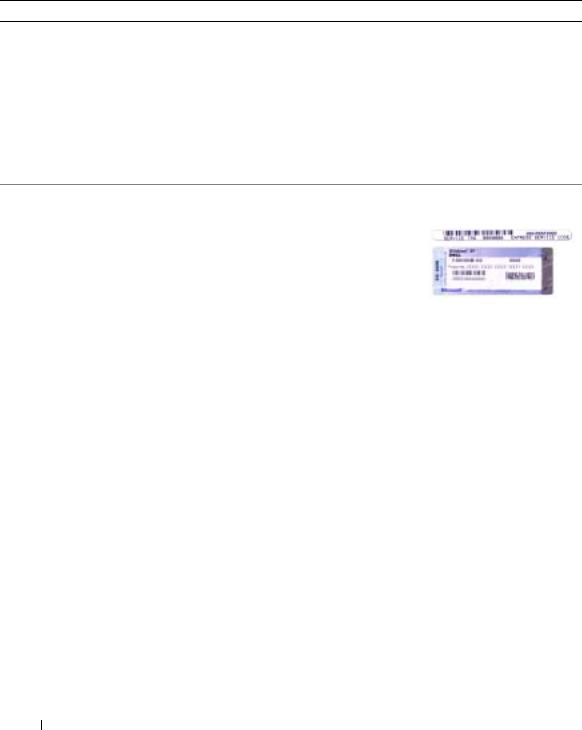
w w w . d e l l . c o m | s u p p o r t . d e l l . c o m
What Are You Looking For?
•How to remove and replace parts
•Specifications
•How to configure system settings
•How to troubleshoot and solve problems
•Service Tag and Express Service Code
•Microsoft Windows License Label
Find It Here
User’s Guide
Access Microsoft® Windows® XP Help and Support Center two ways:
• Double-click the User’s Guide icon on your desktop
OR:
1 Click the Start button and click Help and Support.
2 Click User’s and system guides and click User’s guides.
The User’s Guide is also available on the optional
Drivers and Utilities CD.
Service Tag and Microsoft Windows License
These labels are located on the bottom of your computer.
• Use the Service Tag to identify your computer when you use support.dell.com or contact
technical support.
•Enter the Express Service Code to direct your call when contacting technical support.
6 Quick Reference Guide

What Are You Looking For? |
Find It Here |
|
|
• Solutions — Troubleshooting hints and tips, articles |
Dell Support Website — support.dell.com |
from technicians, online courses, frequently |
NOTE: Select your region to view the appropriate |
asked questions |
support site. |
• Community — Online discussion with other |
NOTE: Corporate, government, and education customers |
Dell customers |
can also use the customized Dell Premier Support website |
• Upgrades — Upgrade information for components, such |
at premier.support.dell.com. The website may not be |
as memory, the hard drive, and the operating system |
available in all regions. |
• Customer Care — Contact information, service call and |
|
order status, warranty, and repair information |
|
• Service and support — Service call status and support |
|
history, service contract, online discussions with |
|
technical support |
|
• Reference — Computer documentation, details on my |
|
computer configuration, product specifications, and |
|
white papers |
|
• Downloads — Certified drivers, patches, and |
|
software updates |
|
• Notebook System Software (NSS) — If you reinstall the |
|
operating system for your computer, you should also |
|
reinstall the NSS utility. NSS provides critical updates |
|
for your operating system and support for |
|
Dell™ 3.5-inch USB floppy drives, Intel® Pentium® M |
|
processors, optical drives, and USB devices. NSS is |
|
necessary for correct operation of your Dell computer. |
|
The software automatically detects your computer and |
|
operating system and installs the updates appropriate |
|
for your configuration. |
|
|
|
• How to use Windows XP |
Windows Help and Support Center |
• Documentation for my computer |
1 Click the Start button and click Help and Support. |
• Documentation for devices (such as a modem) |
2 Type a word or phrase that describes your problem and |
|
click the arrow icon. |
|
3 Click the topic that describes your problem. |
|
4 Follow the instructions on the screen. |
Quick Reference Guide |
7 |
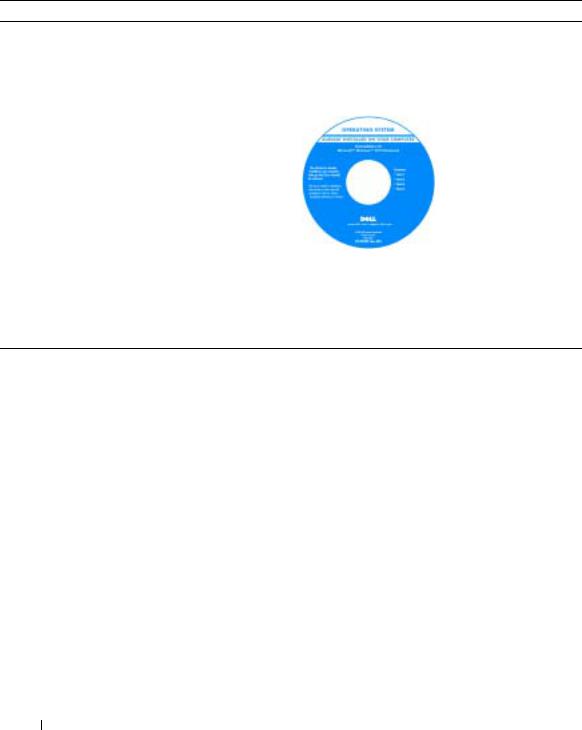
w w w . d e l l . c o m | s u p p o r t . d e l l . c o m
What Are You Looking For?
• How to reinstall my operating system
Find It Here
Operating System CD
The operating system is already installed on your computer. To reinstall your operating system, use the
Operating System CD. See your Latitude User’s Guide for instructions.
After you reinstall your operating system, use the
Drivers and Utilities CD to reinstall drivers for the devices that came with your computer.
Your operating system product key label
is located on your computer.
NOTE: The color of your CD varies based on the operating system you ordered.
NOTE: The Operating System CD is optional and may not ship with your computer.
8 Quick Reference Guide
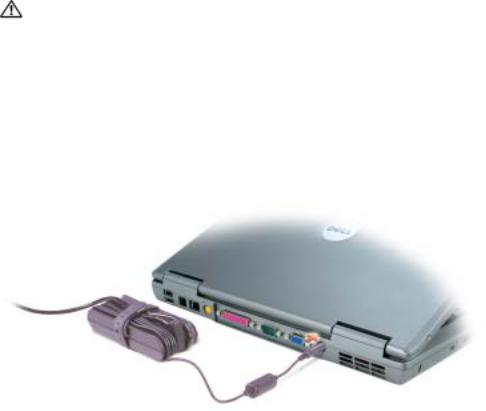
Setting Up Your Computer
CAUTION: Before you begin any of the procedures in this section, follow the safety instructions in the
Product Information Guide.
1Unpack the accessories box.
2Set aside the contents of the accessories box, which you will need to complete the setup of your computer.
The accessories box also contains user documentation and any software or additional hardware (such as PC Cards, drives, or batteries) that you have ordered.
3Connect the AC adapter to the AC adapter connector on the computer and to the electrical outlet.
Quick Reference Guide |
9 |

w w w . d e l l . c o m | s u p p o r t . d e l l . c o m
4 Open the computer display and press the power button to turn on the computer.
 power button
power button
NOTE: Do not connect the computer to the docking device until the computer has been turned on and shut down at least once.
Battery Performance
CAUTION: Before you begin any of the procedures in this section, follow the safety instructions in the
Product Information Guide.
NOTE: For information about the Dell warranty for your computer, see the Product Information Guide or separate paper warranty document that shipped with your computer.
10 Quick Reference Guide

For optimal computer performance and to help preserve BIOS settings, operate your Dell™ portable computer with the main battery installed at all times. Use a battery to run the computer when it is not connected to an electrical outlet. One battery is supplied as standard equipment in the battery bay.
NOTE: Battery operating time (the time the battery can hold a charge) decreases over time. Depending on how often the battery is used and the conditions under which it is used, you may need to purchase a new battery during the life of your computer.
Battery operating time varies depending on operating conditions. You can install an optional second battery in the module bay to significantly increase operating time. For more information about the second battery, see your User’s Guide.
Operating time is significantly reduced when you perform operations including, but not limited to, the following:
•Using optical drives, such as DVD and CD drives
•Using wireless communications devices, PC Cards, or USB devices
•Using high-brightness display settings, 3D screen savers, or other power-intensive programs such as 3D games
•Running the computer in maximum performance mode
NOTE: It is recommended that you connect your computer to an electrical outlet when writing to a CD or DVD.
You can check the battery charge before you insert the battery into the computer. You can also set power management options to alert you when the battery charge is low.
CAUTION: Using an incompatible battery may increase the risk of fire or explosion. Replace the battery only with a compatible battery purchased from Dell. The lithium-ion battery is designed to work with your Dell computer. Do not use a battery from other computers with your computer.
CAUTION: Do not dispose of batteries with household waste. When your battery no longer holds a charge, call your local waste disposal or environmental agency for advice on disposing of a lithium-ion battery. See "Battery Disposal" in the Product Information Guide.
CAUTION: Misuse of the battery may increase the risk of fire or chemical burn. Do not puncture, incinerate, disassemble, or expose the battery to temperatures above 65°C (149°F). Keep the battery away from children. Handle damaged or leaking batteries with extreme care. Damaged batteries may leak and cause personal injury or equipment damage.
Quick Reference Guide |
11 |
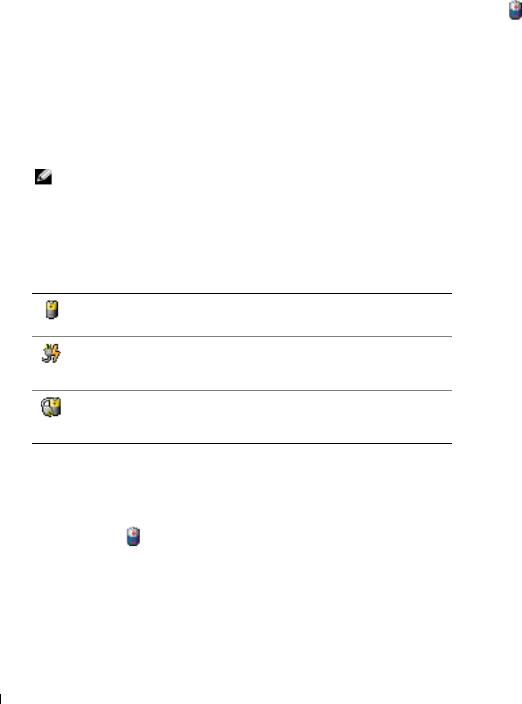
w w w . d e l l . c o m | s u p p o r t . d e l l . c o m
Checking the Battery Charge
The Dell QuickSet Battery Meter, the Microsoft® Windows® Power Meter window and icon, the battery charge gauge and health gauge, and the low-battery warning provide information on the battery charge.
For more information about checking the charge on the second battery, see your User’s Guide.
Dell™ QuickSet Battery Meter
If Dell QuickSet is installed, press <Fn><F3> to display the QuickSet Battery Meter.
The Battery Meter window displays status, charge level, and charge completion time for the battery in your computer.
NOTE: You can use your docking device to charge a computer battery. However, a battery in a docking device does not power the docking device or computer.
In addition, when your computer is connected to a docking device (docked), the Battery Meter window includes a Dock Battery tab, which displays the charge level and current status of the docking device battery.
The following icons appear in the Battery Meter window:
•The computer or docking device is running on battery power.
•The battery is discharging or idle.
•The computer or docking device is connected to an electrical outlet and running on AC power.
•The battery is charging.
•The computer or docking device is connected to an electrical outlet and running on AC power.
•The battery is fully charged.
For more information about QuickSet, right-click the  icon in the taskbar, and click Help.
icon in the taskbar, and click Help.
Microsoft® Windows® Power Meter
The Windows Power Meter indicates the remaining battery charge. To check the Power Meter, double-click the icon on the taskbar. For more information about the Power Meter tab, see your User’s Guide.
If the computer is connected to an electrical outlet, a  icon appears.
icon appears.
12 Quick Reference Guide
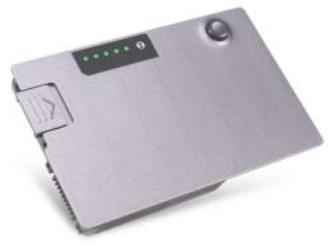
Charge Gauge
Before you insert a battery, press the status button on the battery charge gauge to illuminate the charge-level lights. Each light represents approximately 20 percent of the total battery charge. For example, if the battery has 80 percent of its charge remaining, four of the lights are on. If no lights appear, the battery has no charge.
Health Gauge
The battery operating time is largely determined by the number of times it is charged. After hundreds of charge and discharge cycles, batteries lose some charge capacity, or battery health. To check the battery health, press and hold the status button on the battery charge gauge for at least 3 seconds. If no lights appear, the battery is in good condition, and more than 80 percent of its original charge capacity remains. Each light represents incremental degradation. If five lights appear, less than 60 percent of the charge capacity remains, and you should consider replacing the battery. See your User’s Guide for more information about the battery operating time.
Quick Reference Guide |
13 |

w w w . d e l l . c o m | s u p p o r t . d e l l . c o m
Low-Battery Warning
NOTICE: To avoid losing or corrupting data, save your work immediately after a low-battery warning. Then connect the computer to an electrical outlet, or install a second battery in the module bay. If the battery runs completely out of power, hibernate mode begins automatically.
A low-battery warning occurs when the battery charge is approximately 90 percent depleted. The computer beeps once, indicating that minimal battery operating time remains. During that time, the speaker beeps periodically. If two batteries are installed, the low-battery warning means that the combined charge of both batteries is approximately 90 percent depleted. The computer enters hibernate mode when the battery charge is at a critically low level. For more information about low-battery alarms, see your User’s Guide.
Charging the Battery
NOTE: The AC adapter charges a completely discharged battery in approximately 1 hour with the computer turned off. Charge time is longer with the computer turned on. You can leave the battery in the computer as long as you like. The battery’s internal circuitry prevents the battery from overcharging.
When you connect the computer to an electrical outlet or install a battery while the computer is connected to an electrical outlet, the computer checks the battery charge and temperature. If necessary, the AC adapter then charges the battery and maintains the battery charge.
If the battery is hot from being used in your computer or being in a hot environment, the battery may not charge when you connect the computer to an electrical outlet.
The battery is too hot to start charging if the  light flashes alternately green and orange. Disconnect the computer from the electrical outlet and allow the computer and the battery to cool to room temperature. Then connect the computer to an electrical outlet to continue charging the battery.
light flashes alternately green and orange. Disconnect the computer from the electrical outlet and allow the computer and the battery to cool to room temperature. Then connect the computer to an electrical outlet to continue charging the battery.
For more information about resolving problems with a battery, see your User’s Guide.
14 Quick Reference Guide
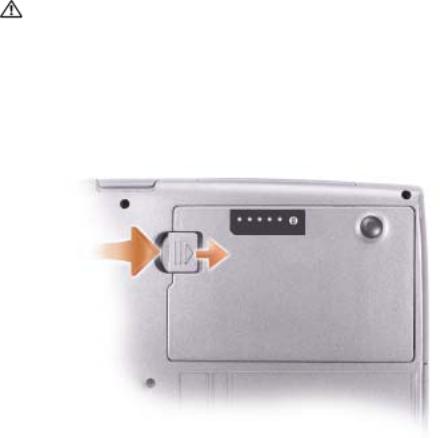
Removing a Battery
CAUTION: Before performing these procedures, disconnect the modem from the telephone wall jack.
For information about removing the second battery, see your User’s Guide.
1Ensure that the computer is turned off, suspended in a power management mode (Hibernation mode), or connected to an electrical outlet.
2If the computer is connected to a docking device (docked), undock it. See the documentation that came with your docking device for instructions.
3Slide and hold the battery-bay (or module-bay) latch release on the bottom of the computer, and then remove the battery from the bay.
Installing a Battery
Slide the battery into the bay until the latch release clicks.
For information about installing the second battery, see your User’s Guide.
Storing a Battery
Remove the battery when you store your computer for an extended period of time. A battery discharges during prolonged storage. After a long storage period, charge the battery fully before you use it.
Quick Reference Guide |
15 |
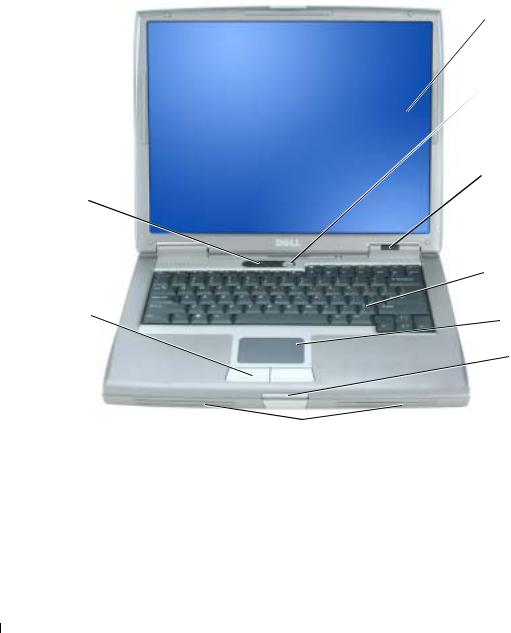
o m |
About Your Computer |
d e l l . c |
Front View |
s u p p o r t . |
|
| |
|
w w w . d e l l . c o m |
|
keyboard status lights
touch pad buttons 
speakers (2)
display
 power button
power button
 device status lights
device status lights
 keyboard
keyboard
 touch pad
touch pad
 display latch
display latch
16 Quick Reference Guide
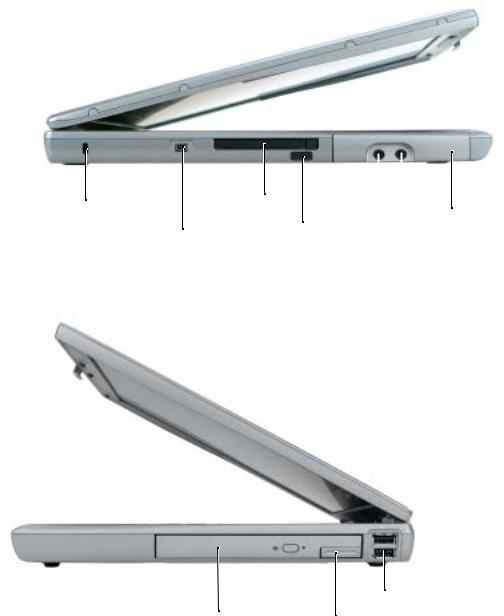
Left View
security cable slot |
PC Card slot |
|
|
hard drive |
|
|
|
||
|
|
|
|
|
IEEE 1394 Connector |
infrared sensor |
|
||
|
|
|
|
|
|
|
|
audio connectors (2) |
|
|
|
|
||
Right View
USB connectors (2)
module bay device
device latch release
Quick Reference Guide |
17 |
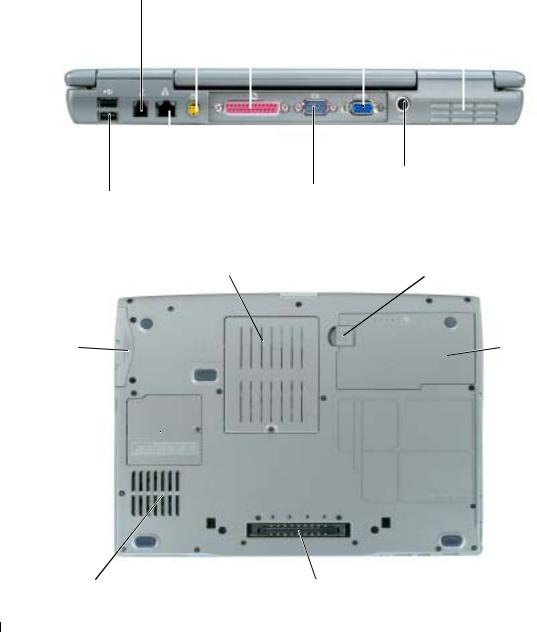
w w w . d e l l . c o m | s u p p o r t . d e l l . c o m
Back View
 CAUTION: Do not block, push objects into, or allow dust to accumulate in the air vents. Do not store your computer in a low-airflow environment, such as a closed briefcase, while it is running. Restricting the airflow can damage the computer or cause a fire.
CAUTION: Do not block, push objects into, or allow dust to accumulate in the air vents. Do not store your computer in a low-airflow environment, such as a closed briefcase, while it is running. Restricting the airflow can damage the computer or cause a fire.
modem connector (RJ-11) |
|
video connector |
|||
|
|||||
|
S-video TV-out connector |
|
|
air vent |
|
|
|
parallel connector |
|
|
|
|
|
|
|
|
|
|
|
|
|
|
|
|
|
|
|
|
|
|
network connector (RJ-45) |
AC adapter connector |
|
||
|
|
|
USB connectors (2) |
serial connector |
|
|
||
Bottom View
memory module cover |
battery-bay latch release |
hard drive |
battery |
communications cover 
fan |
docking device slot |
|
18 Quick Reference Guide
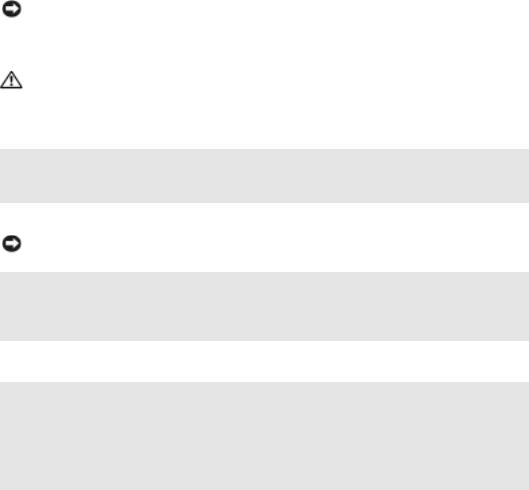
Solving Problems
Notebook System Software
Notebook System Software (NSS) is a utility that provides critical updates for your operating system. Install the Notebook System Software program to gain support for Dell 3.5-inch USB floppy drives, Intel® Pentium® M processors, Intel Celeron® M processors, optical drives, and USB devices. NSS is necessary for correct operation of your Dell computer.
NOTICE: NSS is critical for the correct operation of USB devices, including the Dell D/Bay, D/Dock, D/Port, and D/View devices.
Lockups and Software Problems
CAUTION: Before you begin any of the procedures in this section, follow the safety instructions in the
Product Information Guide.
The computer does not start up
ENSURE THAT THE AC ADAPTER IS FIRMLY CONNECTED TO THE COMPUTER AND TO THE
ELECTRICAL OUTLET
The computer stops responding
NOTICE: You might lose data if you are unable to perform an operating system shutdown.
TURN THE COMPUTER OFF — If you are unable to get a response by pressing a key on your keyboard or moving your mouse, press and hold the power button for at least 8 to 10 seconds until the computer turns off. Then restart your computer.
A program stops responding
END THE PROGRAM —
1 Press <Ctrl><Shift><Esc> simultaneously.
2 Click Applications.
3 Click the program that is no longer responding.
4 Click End Task.
Quick Reference Guide |
19 |

w w w . d e l l . c o m | s u p p o r t . d e l l . c o m
A program crashes repeatedly
NOTE: Software usually includes installation instructions in its documentation or on a floppy disk or CD.
CHECK THE SOFTWARE DOCUMENTATION — If necessary, uninstall and then reinstall the program.
A program is designed for an earlier Windows operating system
IF YOU ARE USING WINDOWS XP, RUN THE PROGRAM COMPATIBILITY WIZARD —
The Program Compatibility Wizard configures a program so it runs in an environment similar to non-Windows XP operating system environments.
1 Click the Start button, point to All Programs→ Accessories, and then click
Program Compatibility Wizard.
2 In the welcome screen, click Next.
3 Follow the instructions on the screen.
A solid blue screen appears
TURN THE COMPUTER OFF — If you are unable to get a response by pressing a key on your keyboard or moving your mouse, press and hold the power button for at least 8 to 10 seconds until the computer turns off. Then restart your computer.
Other software problems
CHECK THE SOFTWARE DOCUMENTATION OR CONTACT THE SOFTWARE MANUFACTURER FOR TROUBLESHOOTING INFORMATION —
•Ensure that the program is compatible with the operating system installed on your computer.
•Ensure that your computer meets the minimum hardware requirements needed to run the software. See the software documentation for information.
•Ensure that the program is installed and configured properly.
•Verify that the device drivers do not conflict with the program.
•If necessary, uninstall and then reinstall the program.
BACK UP YOUR FILES IMMEDIATELY
USE A VIRUS-SCANNING PROGRAM TO CHECK THE HARD DRIVE, FLOPPY DISKS, OR CDS
20 Quick Reference Guide
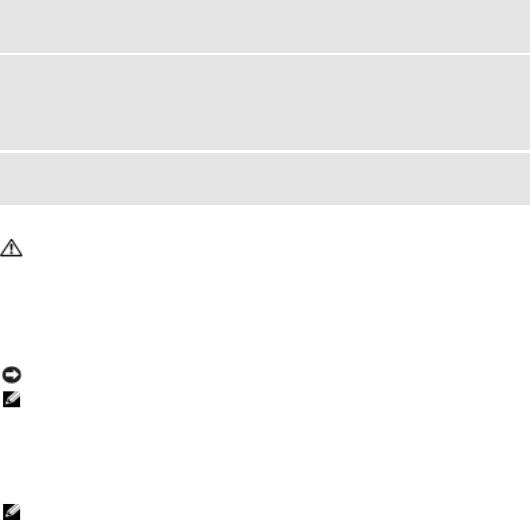
SAVE AND CLOSE ANY OPEN FILES OR PROGRAMS AND SHUT DOWN YOUR COMPUTER THROUGH THE
Start MENU
S — If you are experiencing slow computer performance, you frequently receive pop-up advertisements, or you are having problems connecting to the Internet, your computer might be infected with spyware. Use an anti-virus program that includes anti-spyware protection (your program may require an upgrade) to scan the computer and remove spyware. For more information, go to support.dell.com and search for the keyword spyware.
RUN THE DELL DIAGNOSTICS — If all tests run successfully, the error condition is related to a software problem.
Running the Dell Diagnostics
CAUTION: Before you begin any of the procedures in this section, follow the safety instructions in the
Product Information Guide.
When to Use the Dell Diagnostics
If you experience a problem with your computer, perform the checks in "Solving Problems" and run the Dell Diagnostics before you contact Dell for technical assistance.
It is recommended that you print these procedures before you begin.
NOTICE: The Dell Diagnostics works only on Dell computers.
NOTE: The Drivers and Utilities CD is optional and may not ship with your computer.
Start the Dell Diagnostics from either your hard drive or from the Drivers and Utilities CD (also known as the ResourceCD).
Starting the Dell Diagnostics From Your Hard Drive
The Dell Diagnostics is located on a hidden diagnostic utility partition on your hard drive.
NOTE: If your computer cannot display a screen image, see "Contacting Dell" section in your
User’s Guide.
1Shut down the computer.
2If the computer is connected to a docking device (docked), undock it. See the documentation that came with your docking device for instructions.
3Connect the computer to an electrical outlet.
Quick Reference Guide |
21 |

w w w . d e l l . c o m | s u p p o r t . d e l l . c o m
4Diagnostics can be invoked one of two ways:
a Turn on the computer. When the DELL™ logo appears, press <F12> immediately. Select Diagnostics from the boot menu and press <Enter>.
NOTE: If you wait too long and the operating system logo appears, continue to wait until you see the Microsoft® Windows® desktop. Then shut down your computer and try again.
b Press and hold the <Fn> key while powering the system on.
NOTE: If you see a message stating that no diagnostics utility partition has been found, run the Dell Diagnostics from the Drivers and Utilities CD.
The computer runs the Pre-boot System Assessment, a series of initial tests of your system board, keyboard, hard drive, and display.
•During the assessment, answer any questions that appear.
•If a failure is detected, the computer stops and beeps. To stop the assessment and restart the computer, press <n>; to continue to the next test, press <y>; to retest the component that failed, press <r>.
•If failures are detected during the Pre-boot System Assessment, write down the error code(s) and see "Contacting Dell" in your User’s Guide before continuing on to the Dell Diagnostics.
If the Pre-boot System Assessment completes successfully, you receive the message Booting Dell Diagnostic Utility Partition. Press any key to continue.
5Press any key to start the Dell Diagnostics from the diagnostics utility partition on your hard drive.
Starting the Dell Diagnostics From the Drivers and Utilities CD
1Insert the Drivers and Utilities CD.
2Shut down and restart the computer.
When the DELL logo appears, press <F12> immediately.
If you wait too long and the Windows logo appears, continue to wait until you see the Windows desktop. Then shut down your computer and try again.
NOTE: The next steps change the boot sequence for one time only. On the next start-up, the computer boots according to the devices specified in system setup.
3When the boot device list appears, highlight CD/DVD/CD-RW Drive and press <Enter>.
4Select the CD/DVD/CD-RW Drive option from the CD boot menu.
5Select the Boot from CD-ROM option from the menu that appears.
6Type 1 to start the ResourceCD menu.
7Type 2 to start the Dell Diagnostics.
22 Quick Reference Guide

8Select Run the 32 Bit Dell Diagnostics from the numbered list. If multiple versions are listed, select the version appropriate for your computer.
9When the Dell Diagnostics Main Menu appears, select the test you want to run.
Dell Diagnostics Main Menu
1After the Dell Diagnostics loads and the Main Menu screen appears, click the button for the option you want.
Option |
Function |
|
|
Express Test |
Performs a quick test of devices. This test typically takes |
|
10 to 20 minutes and requires no interaction on your |
|
part. Run Express Test first to increase the possibility of |
|
tracing the problem quickly. |
|
|
Extended Test |
Performs a thorough check of devices. This test typically |
|
takes 1 hour or more and requires you to answer |
|
questions periodically. |
|
|
Custom Test |
Tests a specific device. You can customize the tests you |
|
want to run. |
|
|
Symptom Tree |
Lists the most common symptoms encountered and |
|
allows you to select a test based on the symptom of the |
|
problem you are having. |
|
|
2If a problem is encountered during a test, a message appears with an error code and a description of the problem. Write down the error code and problem description and follow the instructions on the screen.
If you cannot resolve the error condition, see "Contacting Dell" section in your User’s Guide.
NOTE: The Service Tag for your computer is located at the top of each test screen. If you contact Dell, technical support will ask for your Service Tag.
3If you run a test from the Custom Test or Symptom Tree option, click the applicable tab described in the following table for more information.
Tab |
Function |
|
|
Results |
Displays the results of the test and any error conditions |
|
encountered. |
|
|
Errors |
Displays error conditions encountered, error codes, and |
|
the problem description. |
|
|
Help |
Describes the test and may indicate requirements for |
|
running the test. |
Quick Reference Guide |
23 |

w w w . d e l l . c o m | s u p p o r t . d e l l . c o m
Tab |
Function |
|
|
Configuration |
Displays your hardware configuration for the selected |
|
device. |
|
The Dell Diagnostics obtains configuration information |
|
for all devices from system setup, memory, and various |
|
internal tests, and it displays the information in the |
|
device list in the left pane of the screen. The device list |
|
may not display the names of all the components |
|
installed on your computer or all devices attached to your |
|
computer. |
|
|
Parameters |
Allows you to customize the test by changing the test |
|
settings. |
|
|
4When the tests are completed, if you are running the Dell Diagnostics from the Drivers and Utilities CD, remove the CD.
5When the tests are complete, close the test screen to return to the Main Menu screen. To exit the Dell Diagnostics and restart the computer, close the Main Menu screen.
24 Quick Reference Guide

Index
B
battery
charge gauge, 13 charging, 14
checking the charge, 12 health gauge, 13 installing, 15 low-battery warning, 14 performance, 10 power meter, 12 removing, 15
storing, 15
C
CD
operating system, 8
computer crashes, 19-20
slow performance, 21 stops responding, 19
D
Dell
support site, 7
Dell Diagnostics, 21
Dell Premier Support
website, 5, 7
diagnostics Dell, 21
Drivers and Utilities CD, 5
documentation device, 5 online, 7 ResourceCD, 5
System Information Guide, 5 User’s Guide, 6
drivers ResourceCD, 5
Drivers and Utilities CD, 5
F
Finding Information, 5
H
hardware
Dell Diagnostics, 21
Help and Support Center, 7
L
labels
Microsoft Windows, 6 Service Tag, 6
M
Microsoft Windows label, 6
O
Operating System
CD, 8
Installation Guide, 8
Operating System CD, 8
P
problems
blue screen, 20 computer crashes, 19-20
computer does not start up, 19 computer stops responding, 19 Dell Diagnostics, 21
lockups, 19 program crashes, 20
program stops responding, 19 programs and Windows
compatibility, 20 slow computer
performance, 21 software, 19-20 spyware, 21
R
reinstalling
Drivers and Utilities CD, 5 ResourceCD, 5
ResourceCD
Dell Diagnostics, 21
Index 25

S
safety instructions, 5
Service Tag, 6
software problems, 20
spyware, 21
Starting the Dell Diagnostics
From the Drivers and
Utilities CD, 22
Starting the Dell Diagnostics
From Your Hard Drive, 21
system views bottom, 18 right side, 17
T
troubleshooting Dell Diagnostics, 21
Help and Support Center, 7
U
User’s Guide, 6
W
warranty, 5
Windows XP
Help and Support Center, 7
Program Compatibility
Wizard, 20
wizards
Program Compatibility Wizard, 20
26 Index
Dell™ Latitude™ D510
Guide de référence rapide
Modèle PP17L
w w w . d e l l . c o m | s u p p o r t . d e l l . c o m

Remarques, avis et précautions
REMARQUE : Une REMARQUE fournit des informations importantes qui vous aident à mieux utiliser votre ordinateur.
AVIS : Un AVIS indique un dommage matériel ou une perte de données potentiels et comment éviter le problème.
 PRÉCAUTION : Une PRÉCAUTION indique un risque potentiel d'endommagement du matériel, de blessure corporelle ou de mort.
PRÉCAUTION : Une PRÉCAUTION indique un risque potentiel d'endommagement du matériel, de blessure corporelle ou de mort.
Abréviations et sigles
Pour obtenir une liste complète des Abréviations et sigles, reportez-vous au Guide d'utilisation (selon votre système d'exploitation, vous devez soit double-cliquer sur l'icône Guide d'utilisation de votre bureau, soit sur le bouton Démarrer, puis sur Centre d'aide et de support, et enfin sur User and system guides [Guides d'utilisation du système]).
Si vous avez acheté un ordinateur Dell™ Série n, les références du présent document concernant les systèmes d'exploitation Microsoft® Windows® ne sont pas applicables.
REMARQUE : Certaines fonctions ne sont pas nécessairement disponibles sur votre ordinateur ou dans tous les pays.
____________________
Les informations contenues dans ce document sont sujettes à modification sans préavis. © 2005 Dell Inc. Tous droits réservés.
La reproduction de ce document, de quelque manière que ce soit, sans l'autorisation écrite de Dell Inc. est strictement interdite.
Marques utilisées dans ce document : Dell, le logo DELL et Latitude sont des marques de Dell Inc. ; Intel, Pentium et Celeron sont des marques déposées de Intel Corporation ; Microsoft et Windows sont des marques déposées de Microsoft Corporation.
D'autres marques et noms commerciaux peuvent être utilisés dans ce document pour faire référence aux entités se réclamant de ces marques et de ces noms ou à leurs produits. Dell Inc. rejette tout intérêt propriétaire dans les marques et les noms commerciaux autres que les siens.
Modèle PP17L
Février 2005 |
Réf. J8413 |
Rév. A00 |
Table des matières
Recherche d'informations . . . . . . . . . . . . . . . . . . . . . . . . . . . . |
31 |
Configuration de votre ordinateur . . . . . . . . . . . . . . . . . . . . . . . . |
35 |
Performances de la batterie . . . . . . . . . . . . . . . . . . . . . . . . . . . |
36 |
Vérification de la charge de la batterie . . . . . . . . . . . . . . . . . . . . . |
38 |
Jauge de batterie Dell QuickSet . . . . . . . . . . . . . . . . . . . . . . |
38 |
Jauge d'alimentation de Microsoft® Windows®. . . . . . . . . . . . . . |
38 |
Indicateur de charge . . . . . . . . . . . . . . . . . . . . . . . . . . . . |
39 |
Jauge d'état. . . . . . . . . . . . . . . . . . . . . . . . . . . . . . . . . |
39 |
Alerte de batterie faible. . . . . . . . . . . . . . . . . . . . . . . . . . . |
40 |
Chargement de la batterie . . . . . . . . . . . . . . . . . . . . . . . . . . . . |
40 |
Retrait de la batterie . . . . . . . . . . . . . . . . . . . . . . . . . . . . . . . |
41 |
Installation d'une batterie . . . . . . . . . . . . . . . . . . . . . . . . . . . . |
41 |
Stockage de la batterie . . . . . . . . . . . . . . . . . . . . . . . . . . . . . |
41 |
À propos de votre ordinateur . . . . . . . . . . . . . . . . . . . . . . . . . . |
42 |
Vue frontale . . . . . . . . . . . . . . . . . . . . . . . . . . . . . . . . . |
42 |
Vue du côté gauche. . . . . . . . . . . . . . . . . . . . . . . . . . . . . |
43 |
Vue du côté droit . . . . . . . . . . . . . . . . . . . . . . . . . . . . . . |
43 |
Vue arrière . . . . . . . . . . . . . . . . . . . . . . . . . . . . . . . . . |
44 |
Vue du dessous . . . . . . . . . . . . . . . . . . . . . . . . . . . . . . . |
44 |
Résolution des problèmes . . . . . . . . . . . . . . . . . . . . . . . . . . . . |
45 |
Notebook System Software. . . . . . . . . . . . . . . . . . . . . . . . . |
45 |
Problèmes de blocage et problèmes logiciels . . . . . . . . . . . . . . . |
45 |
Lancement de Dell Diagnostics. . . . . . . . . . . . . . . . . . . . . . . |
47 |
Index . . . . . . . . . . . . . . . . . . . . . . . . . . . . . . . . . . . . . . . . . |
51 |
Table des matières |
29 |

30 Table des matières
